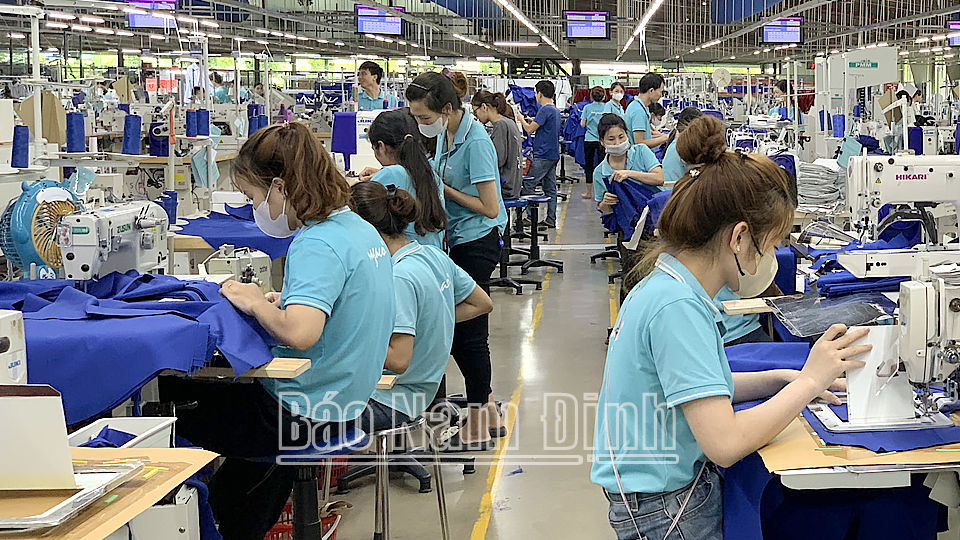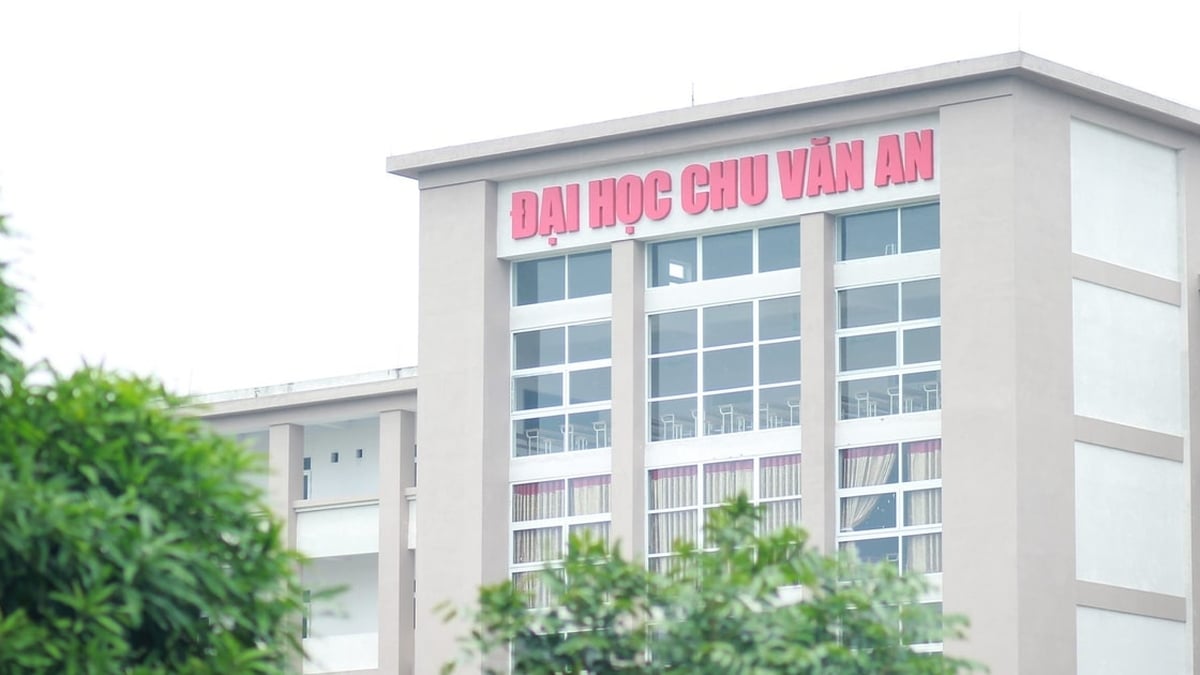 |
| Export production at Nam Dinh Garment Joint Stock Company (Nagaco). |
Closely follow the market, accelerate the "sprint" during the tax deferral period
A representative of Song Hong Garment Joint Stock Company, one of Nam Dinh's large-scale textile and garment enterprises, with 80% of its output exported to the US market, commented: "Even a 10% tax rate is large enough to put significant pressure on profit margins. If a 46% tax rate is implemented, many enterprises will be at risk of losing competitiveness, even threatening their existence." Exporting enterprises in the industry also affirmed that the average profit margin of the textile and garment industry is already very thin (currently fluctuating at only 5-12%), having to compete fiercely with other countries, so the 46% tax rate, if implemented, is really a big challenge for textile and garment enterprises. In the immediate future, many enterprises predict that the US market will have a decrease in demand.
Seizing the “golden opportunity” of the 90-day suspension of reciprocal import tax at a rate of up to 46%, textile and garment enterprises are accelerating the export of contract orders to the US; at the same time, they have made efforts to negotiate closely with customers, calculating the risk sharing of the current 10% tax rate, as well as tax issues after the 90-day period to regulate production costs in the most effective way. Textile and garment enterprises said that through discussions with partners, the general trend is that partners will seek to negotiate and share part of the increased tax with manufacturers in Vietnam, India, Bangladesh... but manufacturers will have to reduce part of the selling price, so profits will certainly decrease.
A representative of Song Hong Garment Joint Stock Company shared: “When applying an additional tax rate of 10%, Song Hong Garment can only absorb a maximum of 1-2%, bearing more pressure will also affect business results, so the tax burden will be shared among three parties: brands, manufacturers and consumers. During the 90-day tax deferral period, Song Hong Garment has received requests from customers to speed up delivery to take advantage of the deferral period. Song Hong Garment's order volume from the US market has been guaranteed until July-August 2025. However, with the assessment that the outlook for the fourth quarter is still uncertain, when even major brands do not have a clear plan, so even in the best scenario, the number of orders in 2025 from the US market will decrease; the second quarter is forecast to grow positively, while the third quarter may begin to weaken”. However, Song Hong Garment Joint Stock Company still decided to maintain the financial target for 2025 with a revenue target of VND 5,500 billion, a growth of 4%, and a record pre-tax profit target of VND 600 billion, 10% higher than the result in 2024. The company believes that it will still achieve the set target because Vietnam will benefit from the wave of brands shifting production from China; especially Vietnam currently has a competitive advantage over potential competitors such as India and Bangladesh due to advantages in production capacity and the ability to meet services. In addition, Song Hong Garment Joint Stock Company is promoting a strategy to enhance the value chain: expanding to the Japanese market, focusing on high-end product lines, investing in research and joint ventures to produce fabrics - a direction that creates proactive input and increases sustainable profits.
Government and localities accompany businesses to overcome "tax storm"
Faced with systemic challenges, the Government and the Prime Minister have directed ministries, sectors and localities to resolutely follow developments, forecast scenarios and respond flexibly. The Vietnam Textile and Apparel Association (VITAS) and related sectors and authorities at all levels have recommended that businesses develop response scenarios, reduce dependence on single markets, develop their own brands and exploit potential markets. The Vietnam Textile and Apparel Group (Vinatex) and the Vietnam Textile and Apparel Association (VITAS) have also proposed to the Government and ministries and sectors support solutions: Reduce VAT for domestic enterprises or increase family deductions for personal taxes of consumers; do not increase electricity bills and some other related costs; loosen credit room to ensure production capital; promote the domestic market of more than 100 million Vietnamese people to offset the shortage of demand in the US market. In addition, localities and relevant agencies have stepped up to create favorable conditions (regarding logistics, customs procedures, etc.) for businesses to speed up delivery as soon as possible during the period of temporary suspension of the application of new reciprocal tax rates.
The functional sectors and localities of the province continue to closely follow the direction of the Central Government and market developments, promptly guide and support the province's textile and garment enterprises to overcome difficulties in the most effective way. The Department of Industry and Trade has proactively guided enterprises to take advantage of the 90-day tax deferral to restructure the market, promote domestic consumption, and reconnect with potential partners that had been overlooked. At the same time, support is provided to remove customs and logistics procedures, clear credit, and reduce production costs. The functional sectors and localities of the province also promote information to enterprises: 16 new-generation free trade agreements (FTAs) have come into effect and may increase to 22 in the coming time; this will be a solid legal foundation for enterprises to expand the market in a sustainable manner, less affected by geopolitical fluctuations. Key markets such as the EU, Japan, South Korea, China, Russia, Belarus and ASEAN and domestic markets are being identified as strategic pillars for exports in 2025. In particular, the European market is increasingly tightening its requirements for green and recycled products - a challenge but also a driving force for businesses to upgrade production and improve chain linkages. According to experts, in the face of increasingly diverse trade barriers, Nam Dinh businesses need to clearly define their strategies: diversifying markets and products; mastering technology, optimizing productivity and quality; proactively adapting to global tariff and environmental barriers.
The spirit of autonomy, innovation and creativity from enterprises, along with the close support of the government from the central to local levels, will hopefully help Nam Dinh textile and garment enterprises overcome difficulties, maintain growth and continue to overcome difficulties and challenges to transform more strongly in the future.
Article and photos: Thanh Thuy
Source: https://baonamdinh.vn/kinh-te/202505/chu-dong-ung-pho-giu-nhip-xuat-khau-det-may-truoc-suc-ep-thue-quan-tu-my-f2e2980/































![[Photo] National Assembly Chairman Tran Thanh Man visits Vietnamese Heroic Mother Ta Thi Tran](https://vphoto.vietnam.vn/thumb/1200x675/vietnam/resource/IMAGE/2025/7/20/765c0bd057dd44ad83ab89fe0255b783)






































































Comment (0)